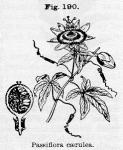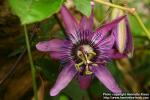 The root and stem-base of Passiflora incarnata, Linné.
The root and stem-base of Passiflora incarnata, Linné.
Nat. Ord.—Passifloraceae.
COMMON NAMES: Passion flower, May pops.
Botanical Source.—A pubescent, climbing shrub, reaching a height of from 20 to 30 feet, and supporting 3 to 5-cleft leaves, the lobes being serrated, and the petiole bearing above 2 glands. The involucre is 3-parted. The flowers are large, wonderful, and handsome, being about 2 inches broad, and of a nearly white color, the crown being triple and of a purplish and flesh-colored or roseate hue. The fruit is the size of a hen's egg, oval, and orange-yellow. It is a perennial herb (G.—W.).
Botanical History.—The genus Passiflora inhabits mainly the tropical portions of America. They are climbing herbs or shrubs, usually with tendrils having alternate, generally palmately divided (some undivided) leaves, with stipules. The flowers are perfect; the calyx is of 5 sepals united at the base to form a cup, and usually have the color of the petals at least on their inner surface. The 5 petals are inserted on the calyx throat, which is a complex, double or triple filamentous crown. The filaments of the 5 stamens are united to form a tubular sheath for the long-stalked ovary, upon which are the 3 club-shaped styles. The anthers are large and fixed by their middle. The many-seeded, 1-celled berry-like fruit is often edible. The seeds are invested by a pulpy substance (Gray).
Two species of this genus have been used to some extent in this country, P. incarnata and P. lutea. The former has now become an important remedy. This species is found within our borders, thriving in dry soils from Virginia to Florida, and from thence westward to Missouri and Arkansas. The common name in our southern states for the fruit is May-pops. The generic name Passiflora is, according to Gray, "an adaptation of flos passionis, a translation of fior della passione, the popular Italian name early applied to the flower from a fancied resemblance of its parts to the implements of the crucifixion." The fruit is orange-colored, about the size of a hen's egg, and filled with a sweetish-yellow pulp. The juice of the leaves of this species, together with those of Passiflora pallida and Passiflora maliformis, were long ago used by the Brazilians for intermittent fevers. The entire plant is used in medicine. Prof. Goss, who introduced it to the Eclectic profession, employed the root and its preparations. We know of physicians who prefer the tincture of the leaves, and others still, who desire the root with a few inches of the stem attached. Passiflora contains small amounts (often traces only) of an alkaloid. Its constituents seem not to possess any decided chemical characteristics.
Passiflora was introduced into medicine in 1839 or 1840 by Dr. L. Phares, of Mississippi, who, in the New Orleans Medical Journal, records some trials of the drug made by Dr. W. B. Lindsay, of Bayou Gros Tete, La. The use of the remedy has been revived within recent years, Prof. I. J. M. Goss, M. D., of Georgia, having introduced it into Eclectic practice.
Action, Medical Uses, and Dosage.—The physiological action of passiflora has not been well-studied. Medicinal doses produce no special physiological impressions, but we have observed even small doses to occasionally provoke emesis; some individuals appear to be very susceptible to this effect. Moderate doses act as an antispasmodic and are somewhat narcotic. Dr. Phares, who introduced the drug, stated that he was satisfied that it possessed no narcotic properties. It is, at least, hypnotic. Excessive doses are said to have produced in animals both spasms and paralysis.
The clinical application of passiflora has been with most observers satisfactory. Its force is exerted chiefly upon the nervous system, the remedy finding a wide application in spasmodic disorders and as a rest-producing agent. It is best adapted to debility and does not act so well in sthenic conditions, although not contraindicated in such. It is specially useful to allay restlessness and overcome wakefulness, when these are the result of exhaustion, or the nervous excitement of debility. It proves specially useful in the insomnia of infants and old people. It gives sleep to those who are laboring under the effects of mental worry or from mental overwork. It relieves the nervous symptoms due to reflex sexual or menstrual disturbances, and the nervous irritability resulting from prolonged illness. We have employed it with good results to allay the restlessness of typhoid fever, although its action appears to be slow, but sure. The sleep induced by passiflora is a peaceful, restful slumber, and the patient awakens quiet and refreshed. A further study of the drug will undoubtedly give us a better guide to its adaptation as a nerve sedative and hypnotic. An atonic condition appears to be the keynote to its selection.
Passiflora is a remedy for convulsive movements. One of its first successful applications in medicine was for the relief of tetanus, both in man and the horse. If given in full doses in epilepsy when the aura gives warning of an approaching attack, the remedy is said to be of considerable value, but after the convulsions have begun it has little or no effect. Some, however, have reported success in all stages of the disease. Passiflora is praised for its control over the spasms of childhood, whether from dentition, worms, or undigested aliment; it has also been successfully employed in trismus nascentium. Spasms, dependent upon meningeal inflammation, have been controlled with it. It appears not to be contraindicated in any form of spasm. Dr. Holmes (Ec. Med. Jour., 1896, p. 55) reports a case of post-partum puerperal eclampsia relieved after but two convulsions by the hypodermatic use of 2 drachms of passiflora. The remedy has given good results in chorea, especially in girls approaching the menstrual age. When whooping-cough is associated with convulsions, passiflora has given relief, and in hysteria with spasmodic movements it is reputed equally successful.
Passiflora is a remedy for pain, particularly of the neuralgic type. Thus it has relieved neuralgic and spasmodic dysmenorrhoea, rectal pain, cardiac pain, facial and other forms of neuralgia, many reflex painful conditions incident to pregnancy and the menopause, and other forms of pain accompanied or not with spasmodic action. Sick or nervous headache, the headache of debility, or from cerebral fullness are often relieved by passiflora. All such cases show marked atony of some part or function.
Passiflora has been employed to relieve many of the nervous phenomena attending la grippe, and both internally and externally has been given to mitigate the ravages of erysipelas (particularly when facial) and syphilis. Prof. Scudder long ago characterized passiflora as a remedy to relieve irritation of the nerve centers, and to improve sympathetic innervation, improving the circulation and nutrition, and stated that it might be used "in torpidity of the liver with hemorrhoids, and in congestion of ovaries and uterus." He employed for the latter purpose fractional doses of the drug (Spec. Med., p. 197). It has been used to check diarrhoea and dysentery. An aqueous extract has been lauded as an application to recent burns and scalds, and to hemorrhoids; also to ulcerating carcinomata, painful ulcers, chancres and chancroids. A pledget of cotton saturated with passiflora and introduced into a carious tooth has promptly allayed violent toothache. The dose of specific passiflora is from a fraction of a drop to 2 fluid drachms.
Specific Indications and Uses.—Irritation of brain and nervous system with atony; sleeplessness from overwork, worry, or from febrile excitement, and in the young and aged; neuralgic pains with debility; exhaustion from cerebral fullness, or from excitement; convulsive movements; infantile nervous irritation; nervous headache; tetanus; hysteria; oppressed breathing; cardiac palpitation from excitement or shock.
Related Species.—Passiflora lutea, Linné. Smooth and slender; summit of the leaves obtusely 3-lobed and lobes entire; glandless petioles and greenish-yellow flowers an inch broad. Damp thickets from Pennsylvania to Florida, and west to Illinois, Missouri and Louisiana. The fruits are acidulous and edible. Used by Dr. Phares, of Mississippi, like Passiflora incarnata.
 Passiflora caerulea, Linné.—Leaves 5-lobed and entire; flowers fringed and greenish, bluish, purplish, or white; fruit, orange-yellow. A native of Brazil, and often cultivated in warm countries for ornamental coverings for walls, houses, and arbors. The fruit is not eaten.
Passiflora caerulea, Linné.—Leaves 5-lobed and entire; flowers fringed and greenish, bluish, purplish, or white; fruit, orange-yellow. A native of Brazil, and often cultivated in warm countries for ornamental coverings for walls, houses, and arbors. The fruit is not eaten.
Passiflora lyraefolia, Tussac.—Leaves unequally 3-cleft at top; flowers red; fruit like a cherry.
Passiflora rubra, Linné—Leaves, 2-lobed; flowers whitish and light red; scarlet berries. Reputed narcotic by inhabitants of Jamaica and the Caribbee Islands.
 Passiflora edulis.—Fruit large, orange-purple externally, orange-colored within. Has an acidulous, orange-flavored taste. Edible.
Passiflora edulis.—Fruit large, orange-purple externally, orange-colored within. Has an acidulous, orange-flavored taste. Edible.
Passiflora alata.—An extract of the leaves with aloes was reputed beneficial in atrophy of various parts.
Passiflora capsularis.—Reputed emmenagogue.
Passiflora foetida, Cavanilles.—Leaves 3-lobed; flowers whitish, with purple crown; odor fetid. Said to be antispasmodic, emmenagogue, and expectorant. Used in poultices.
Passiflora laurifolia, Laurel-leaved granadilla.—West Indies. Known also as Water lemon and Honey-suckle by the English, Pomme de Liane by the French, and in South America as Granadilla and Murucaja. Fruit about the size of a hen's egg. Yellow and dotted with white; the pulp is whitish and water, and the juice, which is peculiarly flavored and agreebly acid, is sucked by Europeans and natives through an opening made in the tough, thin rind. "It is said that it quenches thirst, allays heat, induces an appetite, and elevates the spirits "(Hogg). The leaves are bitter, and considered anthelmintic and moderately astringent.
Passiflora maliformis, Linné, Apple-fruited granadilla, or Sweet calabash.—Flowers white and fringed with blue. Fruit is dull yellow and resembles an apple in size and shape. Pulp gelatinous, pale yellow, very agreeably acid, and usually eaten with wine and sugar. Juice of the leaves used in Brazil in intermittent fevers (Hogg).
Passiflora contrayerva.—Root sweetish, pungent and fragrant. Reputed "counter-poison, deobstruent and cordial."
 Passiflora quadrangularis, Linné.—Branches 4-angled and winged. Fruit large as a goose egg, and of a greenish-yellowish color. Native of Jamaica and South America and known as the Common granadilla, or Granadilla vine. The sweet, acidulous, purple-colored pulp is the edible portion. The root is reputed very poisonous, causing emesis, convulsions, paralysis and death. Small doses of the root are said to act as an anthelmintic. An active principle, somewhat like morphine, has been isolated from the root and named passiflorine.
Passiflora quadrangularis, Linné.—Branches 4-angled and winged. Fruit large as a goose egg, and of a greenish-yellowish color. Native of Jamaica and South America and known as the Common granadilla, or Granadilla vine. The sweet, acidulous, purple-colored pulp is the edible portion. The root is reputed very poisonous, causing emesis, convulsions, paralysis and death. Small doses of the root are said to act as an anthelmintic. An active principle, somewhat like morphine, has been isolated from the root and named passiflorine.
Murucuja ocelatta.—West Indies. "Anthelmintic, diaphoretic and antihysteric" (Hogg). An infusion and syrup are used in Jamaica, like A vinous or spirituous tincture of the flowers is employed under the name of Bull-hoof or Dutchman's laudanum, as an efficient and easy narcotic.
Modecca palmetta.—Reputed tonic and pectoral, and Modecca integrifolia), beaten with butter, is said to "heal hemorrhoids."
Adenia venenata.—Africa. A climber known as Passion flower in its habitat. Lauded as a vesicant by Schweinfurth.

